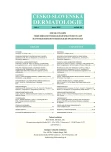Skin Changes after Renal Transplantation: the First Results of Clinical Follow-up
Authors:
P. Cetkovská 1; H. Szakos 1; F. Šefrna 2; T. Reischig 2
Authors‘ workplace:
Dermatovenerologická klinika FN a LFUK, Plzeň, přednosta prof. MUDr. Karel Pizinger, CSc.
1; I. interní klinika FN a LFUK, Plzeň, přednosta prof. MUDr. Martin Matějovič, Ph. D.
2
Published in:
Čes-slov Derm, 86, 2011, No. 1, p. 13-16
Category:
Clinical and laboratory Research
Overview
The aim of our study
was to examine and follow patients after renal transplantation in the years from 2005 to 2010. These patients, due to the long-term immunosuppression, show an increased risk of skin tumors, especially, of non-melanoma skin cancer. In collaboration with transplant unit we repetitively examined 258 kidney transplant recipients including 165 males (64%) and 93 females (36%), of a mean age of 53 years, with an average time 8 years after transplantation and so the same time of immunosuppressive treatment. Most of them belonged to the phototype II and III. In spite of nephrologists and dermatologists recommendation only 33.3 % of patients used sunscreens and 20.5% clothes for photoprotection, but 45.7% of transplant recipients did not used any photoprotection. Skin tumors were diagnosed in 55 patients (21.3%): 27 squamous cell carcinomas in 23 patients (8.9%) including 13 patients with 14 carcinomas in situ (5.1%) and 60 basal cell carcinomas in 36 patients (14%). We treated actinic keratoses in 37 patients (14.3%). In 3 patients 4 malignant melanomas (1.2%) were found. We observed viral warts in 24.4% and atypical melanocytic nevi in 10.8% of cases. Statistically significant correlation of the skin cancer development and the patient’s age, the skin phototype and the length of immunosuppression was found. Only 9.3% of patients suffered from pruritus during hemodialysis treatment before transplantation. The results showed that kidney transplant recipients are at risk, especially, of non-melanoma skin cancer development and their sun photoprotection habits are insufficient. Therefore, regular dermatologic follow-up and proper education on the everyday photoprotection necessity are important.
Key words:
kidney transplantion – immunosuppressive therapy – hemodialysis – skin cancer – photoprotection
Sources
1. CETKOVSKÁ, P. Dermatologie v transplantační medicíně. Čes-slov Derm, 2007, 82, 6, p. 317–327.
2. CETKOVSKÁ, P., PIZINGER, K., ŠTORK, J. Kožní změny u interních onemocnění. Praha: Grada, 2010, 240 p.
3. CALLEN, J. P., JORIZZO, J. L. (Eds.) Dermatological signs of internal diseases. 3rd ed. Spain : Elsevier Science, 2003, 374 p.
4. ENGEL, F., ELLERO, B., WOEHL-JEAGLE, M. L., CRIBIER, B. Diffuse sebaceous hyperplasia of face induced by cyclosporine. Ann. Dermatol. Venereol., 2005, 132, 4, p. 342–345.
5. HO, W. L., MURPHY, G. M. Update on the pathogenesis of post-transplant skin cancer in renal transplant recipients. Br. J. Dermatol., 2008, 158, 9, p. 217–224.
6. HOFBAUER, G. F. L., BOUWES BAVINCK, J. N., EUVRARD, S. Organ transplantation and skin cancer: basic problems and new perspectives. Experimental Dermatol., 2010, 19, p. 473–482.
7. KELLER, B., BRAATHEN, L. R., MARTI, H. P., HUNGER, R. E. Skin cancers in renal transplant recipients: A description of the renal transplant cohort in Bern. Swiss Med. Wkly, 2010, early online.
8. KUMPOVÁ, M., CETKOVSKÁ, P., OPATRNÁ, S. Kožní nálezy u dialyzovaných pacientů s chronickým selháním ledvin. Čes-slov Derm, 2008, 83, p. 259–264.
9. MAHÉ, E., MORELON, E., LECHATON, S. et al. Acne in recipients of renal transplantation treated with sirolimus: clinical, microbiologic, histologic, therapeutic and pathogenic aspects. J. Am. Acad. Dermatol., 2006, 55, p.139–142.
10. MIRE, L. L., HOLLOWOOD, K., GRAY, D., BORDEA, C., WOJNAROVSKA, F., Melanomas in renal organ recipients. Br. J. Dermatol., 2006, 154, 3, p. 472–477.
11. OTLEY, C. C., CHERIKH, W. S., SALASCHE, S. J. et al. Skin cancer in organ transplant recipients. J. Am. Acad. Dermatol., 2005, 53, p. 783–790.
12. STALLONE, G., SCHENA, A., INFANTE, B. et al. Sirolimus for Kaposi´s sarcoma in renal transplant recipients. N. Engl. J. Med., 2005, 352, p. 1317–1323.
13. TAN, H. H., GOH, C.H. L. Viral infections affecting the skin in organ transplant recipients: epidemiology and current management strategy. Am. J. Clin. Dermatol., 2006, 7, 1, p. 13–29.
14. TERHORST, D., DRECOLL, U., STOCKFLETH, E. Organ transplant recipients and skin cancer: assesment of risk factors with focus on sun exposure. Br. J. Dermatol., 2009, 161, suppl.3, p. 85–89.
15. ULRICH, C., KANITAKIS, J., STOCKFLETH, E., EUVRARD, S. Skin cancer in organ transplant recipient-Where do we stand today? Am. J. Transplant., 2008, 8, p. 2192–2198.
16. ULRICH, C., JURGENSEN, J. S., STOCKFLETH, E. et al. Prevention of non-melanoma skin cancer in organ transplant patiens by regular use of sunscreen. Br. J. Dermatol., 2009, 161, suppl. 3, p. 78–84.
17. VIKLICKÝ, O. Imunosuprese po transplantaci ledviny. Klinická farmakologie a farmacie, 2010, 24, p. 98–102.
18. WISGERHOF, H. C., EDELBROEK, J. R. J., DE FIJTER, J. W., FELTKAMP, M. C. W., WILLEMZE, R., BOUWES BAVINCK, J. N. Trends of skin diseases in organ-transplant recipients transplanted between 1966 and 2006: a cohort study with follow-up between 1994 and 2006. Br. J. Dermatol., 2009, 162, 2, p. 390–396.
Labels
Dermatology & STDs Paediatric dermatology & STDsArticle was published in
Czech-Slovak Dermatology

2011 Issue 1
Most read in this issue
- Successful Treatment of Severe Hidradenitis Suppurativa with Adalimumab
- Hidradenitis suppurativa
- Clinical Pathological Aspects of Pendulating Soft Fibroma
- Autoimmune Hepatitis during by Infliximab Treatment of Psoriasis: Case Report
